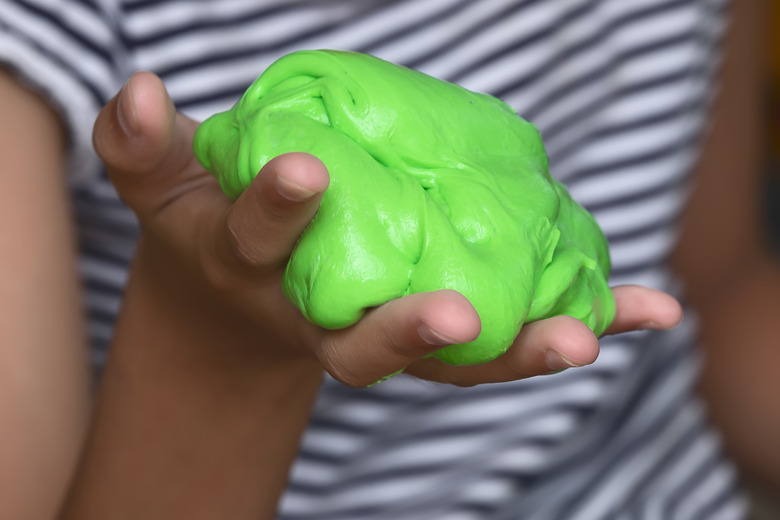How To Make Slime For Kids Without Borax, Food Coloring And White Glue
Sticky, gooey slime is a fun DIY project with kids, but many of the standard recipes call for problematic ingredients such as borax – a skin irritant – white glue and food coloring. If you'd like to avoid the mess and mild toxicity of those recipes, there are several other versions of slime you can make with common household ingredients. They're all non-toxic and clean up easily with soap and water, or by eager little tongues in the case of the sweetened version.
Cornstarch Slime
Cornstarch Slime
One of the simplest slime recipes calls for just two ingredients, cornstarch and warm water. The standard version uses two parts cornstarch to one part water by volume, so if you have 2 cups of cornstarch you'd use 1 cup of water. Place the cornstarch in a mixing bowl and add the water slowly, mixing it with your hands as it moves past the caked-up stage to become a loose almost-liquid. You should be able to shape it into a ball with your hands, but the moment you stop working with it it should ooze out between your fingers in long, goopy strings. If it's too stiff to flow properly add a few drops of water until it does; if it's too loose, you can work another sprinkling of cornstarch into the mixture.
Fiber-Laxative Slime
Fiber-Laxative Slime
Some popular laxative powders are made of psyllium, the ground-up seeds of a type of plantain. The powder will thicken water to a gloriously thick and sticky version of slime, though this one needs to be made ahead. Measure just 1 teaspoon of the laxative powder into large, microwaveable bowl, and then add a cup of water. Microwave the mixture until it boils up in a huge cloud of bubbles – it can take anywhere from one to four minutes, so do not leave this unattended – and then let it rest for a few minutes. Repeat this process five or six times, until the powder is fully gelled. Pour out the mixture onto a parchment-lined cookie sheet, spread it out with a spatula or the back of a spoon, and let it cool to room temperature. It should hold its shape when you're not handling it, but it will ooze and flow in the warmth of your hand.
Oil and Cornstarch Slime
Oil and Cornstarch Slime
Cornstarch's thickening and slime-making powers aren't limited to using it with water. You can also make slime with cornstarch and vegetable oil, for a rather different approach. You'll need about 3/4 cup of cornstarch for 2 cups of oil. Stir them together until they're well mixed, and then refrigerate them in a plastic bag or container for at least a few hours until play time rolls around. Re-mix the ingredients – they do separate – and then pour out the slime. It's thicker and gooier when it's cold and becomes runnier as it warms up. You can increase or decrease the amount of cornstarch, if you like, to tweak the consistency.
Sweet, Sticky Edible Slime
Sweet, Sticky Edible Slime
One version of slime that's especially appealing for young kids is a sweet, edible recipe based on sweetened condensed milk, the same kind you'd use in a key lime pie or other desserts. Empty a whole 14-ounce can of the milk into a small saucepan over gentle heat, and whisk in a tablespoon of cornstarch. Keep stirring until the cornstarch thickens the already sticky milk to the consistency of a stiff sauce, and then remove the saucepan from the stove and let it cool.
Some Practicalities for Parents or Teachers
Some Practicalities for Parents or Teachers
Each of these versions of slime should be kept in the refrigerator when they're not in use because they use food ingredients, and they are at least moderately perishable. The edible version should be discarded after two days, and the others will keep nicely for a week or so without acquiring any odd smells. Slime will clog your drains, so it's best disposed of in the garbage or your compost. Making slime is half the fun, of course, so whipping up a new batch isn't usually an issue.
If you want to avoid the use of clothes-staining food colorings, but would like the option of adding fun colors to your slime, look for non-staining, kid-friendly finger paints in powder or liquid form. Add a few shakes or drops to your mixture as needed to bring some cheery color to your DIY fun. These aren't intended for consumption, of course, so don't add them to the edible slime.
Cite This Article
MLA
Decker, Fred. "How To Make Slime For Kids Without Borax, Food Coloring And White Glue" sciencing.com, https://www.sciencing.com/make-food-coloring-white-glue-8231353/. 9 March 2018.
APA
Decker, Fred. (2018, March 9). How To Make Slime For Kids Without Borax, Food Coloring And White Glue. sciencing.com. Retrieved from https://www.sciencing.com/make-food-coloring-white-glue-8231353/
Chicago
Decker, Fred. How To Make Slime For Kids Without Borax, Food Coloring And White Glue last modified March 24, 2022. https://www.sciencing.com/make-food-coloring-white-glue-8231353/
